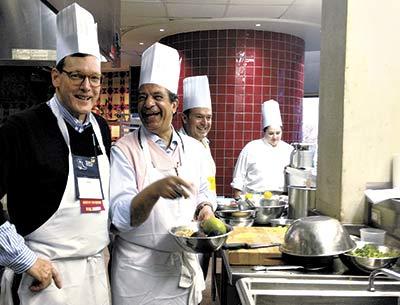News For Foodies: 05.14.15
News For Foodies: 05.14.15
Reopenings
Bay Kitchen and Bar, the restaurant at Harbor Marina on Three Mile Harbor in Springs, will reopen for the season tonight and serve dinner on Thursdays through Sundays until July, when it will be open daily. From 4 to 7 p.m. nightly, the restaurant has a happy hour at the bar, with $1 oysters and $5 glasses of rosé.
New menu items this year include red snapper ceviche, mustard and herb-crusted Montauk tuna, seafood pasta, and mushroom fricassee polenta. A new beverage director, Maura McGuigan, has joined Eric and Adam Miller, the restaurant’s father-and-son co-owners, and will be offering new libations.
Also open again this week is Rowdy Hall in East Hampton, which suffered damage in a fire that gutted most of a neighboring Main Street building last month. The restaurant opened its doors last Thursday for a thank-you party for emergency responders, and was back to regular lunch and dinner service on Friday.
New Hampton Seafood
The Hampton Seafood Co. in East Hampton has new ownership and an executive chef, Ian Lowell. Catering services include a clambake menu, barbecue menu, and a la carte dishes including appetizers, hors d’oeuvres, entrees, sides, desserts, and raw bar items.
Parties can also be catered with a variety of food stations: a taco station, pasta station, slider station, and “artisanal” station featuring fruit, cured meats, dips, crackers, cheeses, and vegetables.
The shop continues to offer a takeout menu with tacos, burritos, and sides, as well as fresh fish and shellfish.
Montauk Eateries
O’Murphy’s in Montauk has decamped from the circle downtown and reopened near the harbor at the Tipperary Inn on West Lake Drive. The restaurant is serving lunch and dinner every day, and breakfast on Sunday.
Dave’s Grill, with a spot overlooking the docks, reopens for the season tonight and will be serving dinner Thursdays through Sundays.
Juice and More
Lisa’s Lovely organic juice bar has opened on Race Lane in East Hampton. The menu includes a wide selection of juices and smoothies as well as acai bowls and daily salad specials. A selection of local and organic products is offered as well.
Get Happy
Bar food, tap beers, and house wine and liquor are half-price at Fresh Hamptons in Bridgehampton each day between 4 and 6 p.m. Among the specially priced menu items are grass-fed beef sliders, organic whole wheat pizza, fish or spicy vegetarian tacos, and snacks such as baked kale chips, steamed edamame, and hand-cut Sagaponack potato fries.
A new happy hour at Indian Wells Tavern in Amagansett will be held Mondays through Fridays from 4 to 6 p.m. and feature discounted drinks and a wide selection of half-price dishes. They include chicken wings, calamari, mussels and fries, nachos, quesadillas, potstickers, and a Mediterranean platter with pita bread, hummus, olives, and eggplant caponata. House wine and well drinks will be $6.
Little Leaguers’ Dinner
At the Harbor Grill in East Hampton, East Hampton Little League players who dine at the restaurant with their families after a game will get a burger for half price, and receive a free scoop of strawberry, vanilla, or chocolate ice cream to top off their meal. They must be in uniform to be offered the deal.





